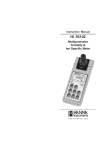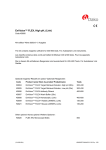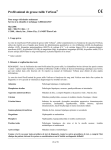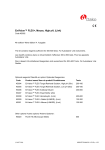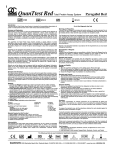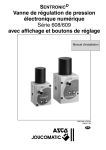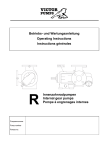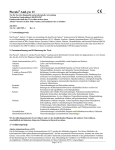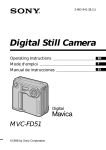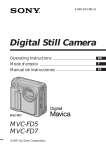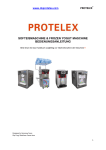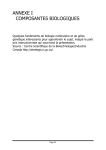Download IL Test TM AST/GOT - 0018252440 10 x 20 mL
Transcript
Clinical Chemistry IL Test TM AST/GOT - 0018252440 10 x 20 mL AST/GOT R1 ENGLISH - Insert revision 05/2003 10 x 11 mL AST/GOT R2 - 1 x 210 mL AST/GOT Buffer Intended Use Indicators of Reagent Deterioration Interferences IL TestTM AST/GOT is intended for the quantitative in vitro diagnostic determination of aspartate aminotransferase (AST or glutamic oxalacetic transaminase, GOT) in human serum and plasma using the ILab Chemistry Systems. AST measurements are used in the diagnosis and treatment of certain types of liver and heart diseases. Refer to the publication “Effects of Diseases on Clinical Laboratory Tests,”1 for a summary of causes of increased and decreased AST. Physical appearance: All reagents should be clear and colorless. Control Assay: The proper range should be obtained during a controlled assay. Absorbance Range: Changes in typical reagent blank absorbances may indicate reagent deterioration. ILab 600: No interference from lipemia up to sample absorbance of 5.0/cm at 660 nm (970 mg/dL triglycerides). No interference up to 70 mg/dL (0.042 mmol/L) hemoglobin. No interference up to 30 mg/dL (510 µmol/L) bilirubin. ILab 900/1800: No interference from lipemia up to sample absorbance of 1.8/ cm at 660 nm. No interference up to 125 mg/dL (0.075 mmol/L) hemoglobin. No interference up to 20 mg/dL (340 µmol/L) bilirubin. For a comprehensive review of interfering substances, refer to the publication by Young.5 Principle/Test Summary Rate analysis. The reagent formulation is according to the recommendations of the IFCC.2 aspartate aminotransferase L-aspartate + 2-oxoglutarate L-glutamate + oxalacetate malate dehydrogenase oxalacetate + NADH + H+ L-malate + NAD+ The rate of decrease in absorbance due to the oxidation of NADH to NAD+ is directly proportional to sample AST activity. Absorbance measurements are taken at 340 nm. The lactate dehydrogenase (LDH) included in the reagent eliminates interference from serum pyruvate. Reactive Ingredients of Final Assay Mixture - - - - - - 2-oxoglutarate L-aspartate Reduced nicotinamide adenine dinucleotide (NADH) Lactate dehydrogenase (LDH) microbial Malate dehydrogenase (MDH) microbial Buffer Tris 12.0 mmol/L 240 mmol/L > 0.180 mmol/L > 600 U/L > 420 U/L pH 7.7 Precautions Contains sodium azide (< 0.1%) that may form explosive azides in metal plumbing. Dilute with water prior to disposal. During disposal into sewerage flush with copious amounts of running water. Metal plumbing should periodically be decontaminaded with 10% sodium hydroxide. Handle all specimens as potentially infectious for HIV or Hepatitis B. Avoid contact with skin and eyes (S24/25). Do not empty into drains (S29). Wear suitable protective clothing (S36). This product is For in vitro Diagnostic Use. Reagent preparation AST/GOT R1: Reconstitute the AST/GOT R1 container with 20 mL of AST/GOT Buffer. Do not shake or allow to foam. Allow the working reagent to stand for 30 minutes before use. Place into reagent tray (ILab 900/1800: place into reagent tray #1). Note: IFCC reference method recommends the use of pyridoxalphosphate as activator. Pyridoxalphosphate auxiliary reagent (PLP) is available separately (Cat. No. 0018162750). If this method is used, add 1.0 mL of prepared PLP to the working AST/GOT RI reagent. AST/GOT R2: Reagent is ready-to-use. Place in reagent tray (ILab 900/1800: place in reagent tray #2). Storage of Unopened Reagents Refrigerated (2-8°C) until expire. See expiration date on the carton. Working Reagent Storage and Stability 10 days on board with pyridoxalphosphate. 15 days on board without pyridoxalphosphate. Specimens Serum, lithium heparinized plasma. Samples should be analyzed as soon as possible after collection or stored refrigerated (2-8°C) for up to 24 hours.2 Samples should be brought to room temperature and mixed before analysis. Calibration Enzyme activity is measured by the rate of production of a chromophore with well defined optical properties. The molar absorptivity constant of NADH is 6.3 x 103. Maintenance of optical properties, fluidics and thermal control is critical to the accuracy of this assay. The ILab continuously monitors fluidics, thermal control and some optical parameters. Automatic daily maintenance monitors additional optical properties. Maintenance procedures are detailed in the ILab Operator’s manual. Any adjustments to the ILab should be immediately followed by performance of daily maintenance and quality control procedures. Any failures in the continuous monitoring, daily maintenance or quality control procedures indicate improper system performance. Reagent blanking should be performed daily or before patient assays if the reagent is used less frequently. Data Analysis The ILab calculates AST activity as follows: VR 1 1 ACTsample (U/L) = EF x ∆A EF = x x x 106 VS E PL Where ACT = activity ∆A = Change in absorbance per minute at 340 nm EF = Enzyme factor VR = Total reaction volume (mL) VS = Total sample volume (mL) E = Molar absorptivity constant PL = Pathlength of cuvette (cm)* * The measurement in the ILab cuvette is (0.5 cm for ILab 600 and 0.6 cm for ILab 900/1800) automatically converted to 1 cm pathlength by the ILab. For AST/GOT in the ILab 900/1800: 0.305 EF = 1 1 x x 0.025 6.3 x 103 x 1 106 = 1936 1 1 EF = x x x 10 0.014 6.3 x 103 1 Activity is expressed in International Units/Liter (U/L). To convert U/L to nKat/L, multiply by 16.67.3 Males: 15 to 48 U/L (250 - 800 nKat/L).6 Females: 9 to 36 U/L (150 - 600 nKat/L).6 These reference ranges assume the use of PLP. IL recommends that each laboratory establish its own reference range since ranges may vary with age, diet, gender, and geographical area. Precision The coefficient of variation (3 samples/run, 20 runs) for a sample with 20 U/L AST should not be greater than 5% within run and 7% total. Typical precision results obtained according to NCCLS protocol.7: ILab 600 Within Run Total Samples/Runs 3/20 3/20 Mean (U/L) 25 25 CV (%) Mean (U/L) 2.3 52 3.8 52 CV (%) 1.0 1.2 ILab 900/1800 Within Run Total 3/20 3/20 13 13 3.8 4.3 50 50 1.3 1.5 Method Comparison Comparison Method (x) Comparison Instrument Slope y intercept Range (U/L) Mean x (U/L) Mean y (U/L) r SE n ILab 600 same reagent ILab 900 1.065 0.10 14 - 2377 97 103 0.998 20.40 115 ILab 900/1800 IFCC Reagent Monarch 37 °C 0.949 5.24 5 - 279 61 62 0.997 5.78 100 Linearity For AST/GOT in the ILab 600: 0.194 Reference Range 6 = 2200 ILab 600 Linearity range (U/L) Linearity range (nKat/L) no rerun 3 - 400 50 - 6668 with rerun 3 - 4000 50 - 66680 ILab 900/1800 no rerun 3 - 400 50 - 6668 with rerun 3 - 1000 50 - 16670 Quality Control Sensitivity Use normal and abnormal controls in accordance with good laboratory practices. Analyze at least once per day. Use at least 2 levels of IL SeraChem® controls, such as SeraChem® Level 1 (Cat. No. 0018162412) and SeraChem® Level 2 (Cat. No. 0018162512). The target values and expected range for this control materials can be found in the insert sheets. For identification and resolution of out-of-control situations, references such as Westgard et al.4 are recommended. Minimum Detection Limit IL Test TM AST/GOT - 0018252440 mAbs change per min per U/L ILab 600 0.44 ILab 900/1800 0.51 All ILab models: 2 U/L (33 nKat/L). DEUTSCH - Packungsbeilage Version 05/2003 Verwendung Anzeichen des Reagenzienzustandes Störungen Zur quantitativen in vitro Bestimmung der Aktivität der Aspartat-Aminotransferase (ASAT/AST; bisherige Bezeichnung: Glutamat-Oxalacetat-Transaminase, GOT) in Serum und Plasma mit dem ILab Analysensystem. Die Bestimmung der ASATAktivität findet Verwendung in der Diagnose und Behandlung bestimmter Arten von Leber-und Herzerkrankungen. Eine Übersicht der klinischen Bedeutung erhöhter bzw. verringerter ASAT-Aktivitäten wurde von Friedmann et al.1 zusammengestellt. Optisches Bild: Alle Reagenzien sollten klar und farblos sein. Qualitätskontrolle: Die Ergebnisse von Qualitätskontrollen müssen im jeweiligen Sollbereich liegen. Absorptionsbereich: Änderungen der typischen Absorption des Reagenzienleerwertes geben Hinweis auf einen verschlechterten Reagenzienzustand. Um die optimale Analysenqualität sicherzustellen, wird empfohlen täglich oder bei selten benutzten Reagenzien unmittelbar vor jeder Analyse einen Reagenzienleerwert zu erstellen. ILab 600: Keine Störung durch Lipämie bis zu einer Probenabsorption von 5,0 /cm bei 660 nm (970 mg/dL Triglyceride). Keine Störung durch Hämoglobin bis zu einer Probenkonzentration von 70 mg/dL (0,042 mmol/L). Keine Störung durch Bilirubin bis zu einer Probenkonzentration von 30 mg/dL (510 µmol/L). ILab 900/1800: Keine Störung durch Lipämie bis zu einer Probenabsorption von 1,8 /cm a 660 nm. Keine Störung durch Hämoglobin bis zu einer Probenkonzentration von 125 mg/dL (0,075 mmol/L). Keine Störung durch Bilirubin bis zu einer Probenkonzentration von 20 mg/dL (340 µmol/L). Eine umfassende Übersicht von möglichen Störfaktoren wurde von Young et al. 5 zusammengestellt. Testprinzip Kinetisches Meßprinzip, IFCC-Empfehlungen.2 ASAT L-Aspartat + 2-Oxoglutarat MDH Oxalacetat + NADH + H+ Probenmaterial L-Glutamat + Oxalacetat L-Malat + NAD + Die Absorptionszunahme aufgrund der Oxidation von NADH zu NAD+ ist proportional zur ASAT-Aktivität in der Probe und wird mit Hilfe von Absorptionsmessungen bei 340 nm quantifiziert. Störungen durch Serum-Pyruvat werden durch LDH im Reagenz eliminiert. Aktive Bestandteile Endkonzentrationen im Test - 2-Oxoglutarat - L-Aspartat - NADH - Lactat-Dehydrogenase (LDH) - Malat-Dehydrogenase (MDH) - Puffer Tris 12 mmol/L 240 mmol/L > 0,18 mmol/L > 600 U/L > 420 U/L pH 7,7 Hinweis Enthält Natriumazid (< 0,1%). In Abflußrohren aus Metall kann dies zur explosiven Bildung von Aziden führen. Vor der Entsorgung mit Wasser verdünnen. Während der Entsorgung mit reichlich Wasser spülen. Abflußrohre aus Metall sollten regelmäßig mit 10%-igem Natriumhydroxid entseucht werden. Alle Proben wie potentiell infektiöses Material behandeln. Berührung mit den Augen und der Haut vermeiden (S24/25). Nicht in die Kanalisation gelangen lassen (S 29). Bei der Arbeit geeignete Schutzkleidung tragen (S36). Dieses Produkt ist nur für die in vitro Diagnostik geeignet. Herstellung der Arbeitslösung AST/GOT R1: Den Inhalt eines R1-Reagenzcontainers mit 20 mL AST/GOT Buffer rekonstituieren. Schaumbildung vermeiden. Die gebrauchsfertige Lösung für 30 Min. Behälter in Reagenzienteller eisetzen (ILab 900/1800: Nr. 1). Bei der IFCC-Referenzmethode wird Pyridoxalphosphat (PLP) als Aktivator empfohlen. Pyridoxalphosphat ist als Zusatzreagenz (mit Gebrauchsanweisung) erhältlich (Best.-Nr. 0018162750). 1,0 mL der PLP Arbeitslösung mit AST/GOT R1 Arbeitslösung mischen. AST/GOT R2: Gebrauchsfertig. Behälter in Reagenzienteller eisetzen (ILab 900/1800: Nr. 2). Lagerung und Haltbarkeit des ungeöffneten Reagenz Gekühlt lagern (2-8°C). Bei sachgemäßer Lagerung ist das Reagenz bis zum aufgedruckten Verfallsdatum haltbar. Lagerung und Haltbarkeit der Arbeitslösung Serum, Plasma (Li-Heparinat). Die Bestimmungen sollten so schnell wie möglich nach der Probennahme erfolgen. Alternativ können die Proben gekühlt (2-8°C) bis zu 24 Stunden aufbewahrt werden.2 Vor Gebrauch müssen die Proben auf Raumtemperatur gebracht und gründlich durchmischt werden. Kalibration Diese Bestimmungsmethode muß nicht kalibriert werden, da im Reaktionsverlauf ein Chromophor mit definierten optischen Eigenschaften gebildet wird. Der Molare Extinktionskoeffizient von NADH bei 340 nm beträgt 6300. Es wird empfohlen, täglich oder bei seiten benutzten Reagenzien unmittelbar vor der Analyse einen Reagenzienleerwert zu ermitteln. Berechnung Die Ergebnisse werden vom ILab-Analysensystem wie folgt berechnet: VR x 106 Präzision Bei Verwendung einer Probe mit einer ASAT-Aktivität von 20 U/L sollte der durchschnittliche Variations-Koeffizient (VK) in der Serie nicht größer als 5% und der VK Gesamt nicht größer als 7% sein (3 Proben/Serie, 20 Serien). Die folgenden typische Präzision Daten wurden nach NCCLS-Protokoll7 ermittelt: Proben/Serien Mittelwert (U/L) VK (%) Mittelwert (U/L)VK (%) 3/20 25 2,3 52 1,0 3/20 25 3,8 52 1,2 ILab 900/1800 VS x E x d ∆A: gemessene Absorptionsänderung pro Minute EF: Enzymfaktor VR: gesamtes Reaktionsvolumen (mL) VS: eingesetztes Probenvolumen (mL) E: Spezifischer Molarer Extinktionskoeffizient d: Schichtdicke der Küvette (cm)* *Die Ergebnisse werden vom ILab-Analysensystem intern auf die verwendete Schichtdicke von 0,6 cm (ILab 900/1800) oder 0,5 cm (ILab 600)umgerechnet. ILab 900/1800: Für diese Bestimmung der ASAT-Aktivität gilt: 0,305 x 106 EF = 0,025 x 6300 x 1 = 1936 ILab 600: Für diese Bestimmung der ASAT-Aktivität gilt: In der Serie Gesamt 3/20 3/20 13 13 3,8 4,3 50 50 1,3 1,5 Methodenvergleich Vergleichsmethode (x) Vergleichssystem Steigung Ordinatenabschnitt Bereich (U/L) Mittelwert x (U/L) Mittelwert y (U/L) r Standardfehler n ILab 600 Gleiches Reagenzen ILab 900 1,065 0,10 14 - 2377 97 103 0,998 20,40 115 ILab 900/1800 IFCC Reagenzen Monarch 37 °C 0,949 5,24 5 - 279 61 62 0,997 5,78 100 Linearität 0,194 x 106 EF = 0,014 x 6300 x 1 = 2200 Um von U/L auf nKat/L umzurechnen, ist mit Faktor 16,67 zu multiplizieren3. Qualitätskontrolle Es ist gängige Laborpraxis, die Qualität der Analyse mit Kontrollmaterialien verschiedender Konzentrationsstufen (normal und pathologisch) zu überprüfen. Mindestens eimal täglich sollte eine Richtigkeitskontrolle durchgeführt werden. Es wird empfohlen, als Kontrollmaterial IL SeraChem® Level 1 (Best.- Nr. 0018162412) und SeraChem® Level 2 (Best.- Nr. 0018162512) zu verwenden. Sollwerte und Bereiche sind der jeweiligen Packungsbeilage zu entnehmen. Algorithmen zur Beurteilung der Qualitätskontrollergebnisse siehe z. B. Westgard et al.4 10 Tage im Gerät mit Pyridoxalphosphat. 15 Tage im Gerät ohne Pyridoxalphosphat. Männer: 15 - 48 U/L (250 - 800 nKat/L).6 Frauen: 9 - 36 U/L (150 - 600 nKat/L).6 Die Referenzbereiche gelten für die Verwendung von Pyridoxalphosphat. Es wird jedem Labor empfohlen, eigene Referenzbereiche zu ermitteln. Der ASAT-Referenzbereich hängt von Alter, Geschlecht, Ernährungsweise und weiteren Faktoren ab. ILab 600 In der Serie Gesamt Enzymaktivität(Probe) (U/L) = ∆A x EF EF = Referenzbereich Linearitätbereich (U/L) Linearitätbereich (nKat/L) ILab 600 bei ausgeschaltetem rerun 3 - 400 50 - 6668 bei eingeschaltetem rerun 3 - 4000 50 - 66680 ILab 900/1800 bei ausgeschaltetem rerun 3 - 400 50 - 6668 bei eingeschaltetem rerun 3 - 1000 50 - 16670 Sensitivität ∆mAbs pro 1 min pro U/L AST ILab 600 0,44 ILab 900/1800 0,51 Untere Nachweisgrenze ILab 600/900/1800: 2 U/L (33 nKat/L). IL Test TM AST/GOT - 0018252440 ESPAÑOL - Revisión Prospecto 05/2003 Uso Indicado Indicadores de Deterioro de los Reactivos Interferencias IL Test™ AST/GOT es para la determinación diagnóstica cuantitativa in vitro de aspartado aminotransferasa (AST) o Transaminasa Glutámico Oxalacético (GOT) en suero y plasma humanos utilizando los analizadores de química clínica ILab. Las medidas de AST se usan en el diagnóstico y tratamiento de ciertos tipos de enfermedades hepáticas y cardíacas. Referirse al artículo “Effects of Diseases on Clinical Laboratory Tests”1 para una recopilación de las causas que determinan un incremento o disminución de AST. Aspecto físico: Todos los reactivos deben ser límpidos e incoloros. Rango del control: El control debe dar un valor dentro del rango establecido. Rango de absorbancia: Variaciones en los valores típicos de absorbancia del blanco de reactivo pueden indicar deterioro del reactivo. Suero o plasma tratada con heparina de litio. Las muestras deben ser analizadas lo mas rápidamente posible luego de recogidas o almacendas a 2-8°C por un máximo de 24 horas.2 Las muestras deben ser llevadas a temperatura ambiente y homogeneizadas antes de analizarlas. ILab 600: No se observa interferencia por lipemia hasta una absorbancia de la muestra de 5,0 /cm a 660 nm (970 mg/dL triglicéridos). No se observa interferencia por hemoglobina hasta concentraciones de 70 mg/dL (0,042 mmol/L). No se observa interferencia por bilirubina hasta concentraciones de 30 mg/dL (510 µmol/L). ILab 900/1800: No se observa interferencia por lipemia hasta una absorbancia de la muestra de 1,8 /cm a 660 nm. No se observa interferencia por hemoglobina hasta concentraciones de 125 mg/dL (0,075 mmol/L). No se observa interferencia por bilirubina hasta concentraciones de 20 mg/dL (340 µmol/L). Para más información acerca de las interferencias, referirse a la publicación de Young.5 Calibración Valores de Referencia La actividad enzimática se mide en base a la velocidad de producción de un cromóforo que posee propiedades ópticas bien definidas. El coeficiente de extinción molar del NADH es 6,3 x 103. El control térmico y de flujos, y el mantenimiento de las propiedades ópticas son críticos para obtener la máxima exactitud en esta determinación. El ILab monitoriza constantemente los flujos, el control de temperatura y algunos parámetros ópticos. El mantenimiento automático diario monitoriza propiedades ópticas adicionales. Las tareas de mantenimiento se describen en detalle en el manual del usuario. Todo ajuste que se efectúe sobre el ILab debe ser seguido inmediatamente por las tareas diarias de mantenimiento y control de calidad. Toda falla en los procedimientos de control de calidad y de mantenimiento diario resultará en el funcionamiento inadecuado del sistema. Se recomienda medir un blanco de reactivo cada día de trabajo, o antes de analizar las muestras si el reactivo es usado menos frecuentemente. Hombres: 15 - 48 U/L (250 - 800 nKat/L).6 Mujeres: 9 - 36 U/L (150 - 600 nKat/L).6 Estos rangos de referencia suponen el empleo de PLP’. IL recomienda que cada laboratorio establezca su propio rango de referencia pues los valores pueden variar de acuerdo al sexo, edad, dieta y area geográfica. Principio/Resumen Análisis cinético. La formulación del reactivo es equivalente a las recomendaciones de la International Federation of Clinical Chemistry (IFCC).2 aspartato aminotransferasa L-aspartato + 2-Oxoglutarato L-glutamato + oxalacetato malato deshidrogenasa oxalacetato + NADH + H+ L-malato + NAD+ La velocidad de disminución de absorbancia debido a la oxidación de NADH a NAD+ es directamente proporcional a la actividad de AST en la muestra. La absorbancia se mide a 340 nm. La lactato deshidrogenasa (LDH) incluida en el reactivo elimina la interferencia debida al piruvato presente en el suero. Componentes Activos en la Solución de Ensayo - 2-oxoglutarato L-aspartato Nicotinamida adenina dinucleósido reducido (NADH) Lactato deshidrogenasa (LDH) microbiana Malato deshidrogenasa (MDH) microbiana Tampón Tris 12,0 mmol/L 240 mmol/L > 0,180 mmol/L > 600 U/L > 420 U/L pH 7,7 Precauciones Contiene azida de sodio (<0,1%) que puede formar azidas explosivas al contacto con las cañerías metálicas del laboratorio. Diluir con agua antes de desechar y lavar con abundante agua durante su desecho. Las cañerías metálicas deben ser descontaminadas periodicamente con hidróxido de sodio al 10%. Tratar las muestras como material potencialmente infectado por VIH o por Hepatitis B. Evítese el contacto con los ojos y la piel (S 24/25). No tirar los residuos por el desagüe (S 29). Usen indumentaria protectora adecuada (S 36). Para uso diagnóstico in vitro. Preparación de los Reactivos AST/GOT R1: Reconstituir el reactivo liofilizado con 20 mL de AST/GOT Buffer en el contenedor AST/GOT R1. Cerrar el contenedor y disolver el contenido mezclando suavemente. No se debe agitar vigorosamente ni permitir la formación de espuma. Dejar el reactivo en reposo durante 30 minutos antes de su uso. Colocar el contenedor en el plato de reactivos (ILab 900/1800: plato No. 1). NOTA: El método de referencia de IFCC recomienda el uso de piridoxalfosfato como activador. El reactivo auxiliar piridoxalfosfato (PLP) se suministra por separado (Cat. No. 0018162750). Si se utiliza éste método, agregar 1,0 mL de reactivo preparado PLP al reactivo de trabajo AST/GOT R1. AST/GOT R2: Reactivo listo para usar. Colocar el contenedor AST/GOT R2 en el plato de reactivos (ILab 900/1800: plato No. 2). Conservación de los Reactivos Sellados Refrigerar a 2-8°C hasta la fecha de caducidad indicada en la etiqueta. Conservación y Estabilidad de los Reactivos Abiertos 10 días en el instrumento con piridoxalfosfato. 15 días en el instrumento sin piridoxalfosfato. Muestras Cómputo de los Resultados La actividad AST se calcula en el ILab como sigue: VR 1 1 ACTmuestra (U/L) = EF x ∆A EF = x x x 106 VS E PL Donde: ACT = Actividad ∆A = Variación de absorbancia por minuto a 340 nm EF = Factor enzimático VR = Volumen total de reacción (mL) VS = Volumen total de muestra (mL)E = Coeficiente de extinción molar. PL = Paso de la cubeta (cm)* * La medida efectuada en cubeta de 0,6 cm (ILab 900/1800) o de 0,5 cm (ILab 600) es automáticamente convertida a paso de cubeta de 1,0 cm por el ILab. Para AST/GOT en el ILab 900/1800: EF = 0,305 1 x 0,025 1 x 6,3 x 103 1 x 106 = 1936 Para AST/GOT en el ILab 600: 0,194 Precisión El coeficiente de variación (3 muestras/ensayo, 20 ensayos) para una muestra con 20 U/L de AST debe ser inferior al 5% dentro de cada ensayo e inferior al 7% para el total de los ensayos. Resultados típicos de precisión obtenidos de acuerdo con el protocolo descrito por el NCCLS.7 son: ILab 600 Muestras/ensayos Media (U/L) CV (%) Media (U/L) CV (%) Dentro ensayo 3/20 25 2,3 52 1,0 Total 3/20 25 3,8 52 1,2 ILab 900/1800 Dentro ensayo 3/20 13 3,8 50 1,3 Total 3/20 13 4,3 50 1,5 Comparación de Métodos Método de comparación (x) Instrumento de comparación Pendiente Intersección con y Rango (U/L) Media x (U/L) Media y (U/L) r SE n ILab 600 Mismo reactivo ILab 900 1,065 0,10 14 - 2377 97 103 0,998 20,40 115 ILab 900/1800 Reactivo IFCC Monarch 37 °C 0,949 5,24 5 - 279 61 62 0,997 5,78 100 Linealidad 1 1 ILab 600 La actividad se expresa en Unidades Internacionales /Litro (U/L) Para convertir U/L a nKat/L, multiplicar por 16,67.3 Rango de linealidad (U/L) Rango de linealidad (nKat/L) sin rerun 3 - 400 50 - 6668 con rerun 3 - 4000 50 - 66680 ILab 900/1800 sin rerun 3 - 400 50 - 6668 con rerun 3 - 1000 50 - 16670 Control de Calidad Sensibilidad EF = x 0,014 x 6,3 x 103 1 x 106 = 2200 Se recomienda el uso de controles normales y anormales en concordancia con las prácticas aceptadas de laboratorio. Comprobar el control al menos una vez por día. Usense por lo menos dos niveles de controles IL SeraChem®, tales como SeraChem® Level 1 (Cat. No. 0018162412) y SeraChem® Level 2 (Cat. No. 0018162512). Ver los valores y los rangos esperados en los folletos adjuntos. Para la identificación y resolución de valores que estén fuera del rango de aceptación, se recomienda la consulta de la publicación de Westgard et al.4 IL Test TM AST/GOT - 0018252440 cambio de mAbs por minuto por U/L ILab 600 0,44 ILab 900/1800 0,51 Límite Minimo de Deteccíon Para todos los sistemas ILab: 2 U/L (33 nKat/L). FRANÇAIS - Révision de la notice 05/2003 Utilisation Signes de Deterioration du Réactif Interférences Le coffret IL Test™ AST/GOT est utilisé pour la détermination quantitative in vitro de l’aspartate aminotransférase (AST) ou sérum glutamate oxaloacétate transaminase (GOT) dans le sérum et le plasma sur l’analyseur ILab. Les mesures d’activité de l’AST sont utilisées pour le traitement et le diagnostic de certains types de maladies cardiaques et hépatiques. Se reporter à la publication “Effects of Diseases on Clinical Laboratory Tests”1 pour une revue des causes d’augmentations ou de diminutions de l’AST. Apparence physique: Tous les réactifs doivent être limpides et incolores. Valeurs des contrôles: Elles doivent se trouver dans la fourchette correspondante au cours d’un test. Limites d’absorbances: Des modifications d’absorbances du blanc réactif peuvent indiquer une détérioration du réactif. ILab 600: Pas d’interférence due à la lipémie pour une absorbance du spécimen jusqu’à 5,0 /cm à 660 nm (970 mg/dl triglicérides). Pas d’interférence due à l’hémolyse jusqu’à 70 mg/dl (0,042 mmol/l) d’ hémoglobine. Pas d’interférence due à la bilirubine jusqu’à 30 mg/dl (510 µmol/l). ILab 900/1800: Pas d’interférence due à la lipémie pour une absorbance du spécimen jusqu’à 1,8 /cm a 660 nm. Pas d’interférence due à l’hémolyse jusqu’à 125 mg/dl (0,075 mmol/l) d’ hémoglobine. Pas d’interférence due à la bilirubine jusqu’à 20 mg/dl (340 µmol/l) de bilirubine. Pour plus de précisions sur les interférences, se reporter à la publication de Young.5 Principe/Condensé Mesure en cinétique. Recommandations I.F.C.C.2 Aspartate L-aspartate + Oxo-2-glutarate aminotransférase L-glutamate + Oxaloacétate Malate Oxaloacétate + NADH + H+ deshydrogénase L-Malate + NAD+ La diminution d’absorbance due à l’oxydation du NADH en NAD+ est directement proportionnelle à l’activité en AST du spécimen. L’absorbance est lue à 340 nm. La lactate deshydrogénase (LDH) incluse dans le réactif élimine l’interférence du pyruvate du sérum. Composition du Melange Reactionell - - - - - - 2-Oxo-glutarate L-aspartate Nicotinamide-adénine-dinucléotide réduit (NADH) Lactate deshydrogénase (LDH) microbienne Malate deshydrogénase (MDH) microbienne Tampon Tris 12,0 mmol/l 240 mmol/l > 0,180 mmol/l > 600 U/l > 420 U/l pH 7,7 Précautions Spécimens Sérum, plasma héparinate de lithium. Les spécimens doivent être analysés le plus tôt possible après le prélèvement ou conservés au réfrigérateur (2-8°C) jusqu’à 24 heures.2 Les spécimens doivent être équilibrés à température ambiante et mélangés avant analyse. Calibrage L’activité enzymatique est déterminée par la vitesse de production d’un chromophore aux propriétés optiques parfaitement définies. Le coefficient d’extinction molaire du NADH est de 6,3 x 103. Une maintenance correcte des systèmes optique, fluidique et de contrôle thermique est essentielle pour ce test. Le ILab vérifie en permancence les systèmes fluidique et de contrôle thermique ainsi qu’un certain nombre de paramètres du système optique. La maintenance quotidienne automatique permet de vérifier d’autres paramètres du système optique. Les procédures de maintenance sont détaillées dans le manuel d’utilisation. Toute intervention sur le ILab doit être immédiatement suivie de procédures de maintenance et de contrôle de qualité. Toute anomalie survenant au niveau du contrôle continu, ou des procédures de maintenance quotidienne et de contrôle de qualité, est l’indication d’un dysfonctionnement du système. IL recommande de réaliser un blanc réactif quotidiennement ou avant chaque série de spécimens, si le réactif est peu utilisé. Analyses des Données Contient de l’azide de sodium (<0,1%) susceptible de former des azides explosifs avec la plomberie metallique du laboratoire. Lors du rejet des solutions dans les canalisations, rincer abondamment a l’eau courante. Les canalisations peuvent être décontaminées périodiquement avec de la soude a 10%. Manipuler les spécimens avec précaution comme s’ils étaient potentiellement infectieux (Hépatite B ou HIV). Eviter le contact avec la peau et les yeux (S24/25). Ne pas jeter les résidus à l’égout (S29). Porter un vêtement de protection approprié (S36). Ce produit est à usage diagnostique in vitro. Préparation du Réactif 1 1 ACTspécimen (U/L) = FE x ∆A FE = x x x 106 VS E TO ou: ACT= Activité ∆A= Variation d’absorbance par FE= Facteur enzymatique minute à 340 nm VR= Volume total de la réaction (ml) VS= Volume total du spécimen (ml) E= Coefficient d’extinction molaire TO= Trajet optique de la cuvette (cm)* * Le ILab convert automatiquement à 1,0 cm. le trajet optique réel de la cuvette de 0,6 cm (ILab 900/1800) ou de 0,5 cm (ILab 600). Pour AST/GOT sur l’ILab 900/1800: 0,305 Conservation des Réactifs non Ouverts Nous vous recommandons d’utiliser des contrôles normaux et pathologiques selon les bonnes pratiques de laboratoire, soit au moins une fois tous les jours. Nous préconisons l’utilisation des deux niveaux de nos contrôles IL, Serachem® 1 Level 1 (réf. 0018162412) et Serachem® Level 2 (réf. 0018162512). Les limites et les valeurs cibles de ces contrôles sont indiquées sur les notices correspondantes. Pour l’identification et le traitement des contrôles hors limites, nous vous recommandons de vous référer à des règles telles que celles de Westgard et col.4 Conservation et Stabilité du Réactif de Travail 10 jours sur l’analyseur avec le phosphate de pyridoxal. 15 jours sur l’analyseur sans le phosphate de pyridoxal. 6,3 x 103 x 1 FE= Réfrigérateur (2-8°C) jusqu’à la date de péremption. Vérifier la date de péremption sur l’emballage. x 1 AST/GOT R1: Reconstituer le flacon de réactif lyophilisé AST/GOT R1 avec 20 ml de AST/GOT Buffer. Ne pas agiter violemment afin d’éviter toute formation de mousse. Laisser s’équilibrer le réactif 30 minutes avant utilisation. Le placer dans le compartiment réactif (ILab 900/1800: No. 1) Notice: La méthode de référence I.F.C.C. recommande l’utilisation du phosphate de pyridoxal (PLP) comme activateur. Le PLP (avec toutes les instructions pour la préparation du réactif) est disponible comme réactif supplémentaire (réf. 0018162750). Ajouter 1,0 ml PLP dans le réActif de travail AST/GOT R1. AST/GOT R2 : Le réactif est prêt à l’emploi. Le placer dans le compartiment réactif (ILab 900/1800: No. 2). 0,025 1 x 106 = 1936 Pour AST/GOT sur l’ILab 600: FE= 0,194 1 1 x x x 106 = 2200 0,014 6,3 x 103 1 L’activité est exprimée en unités internationales par litre (U/l). Pour convertir les U/l en nKat/l, multiplier par 16,67.3 Contrôle de Qualité Instrumentation Laboratory SpA - V.le Monza 338 - 20128 Milano (Italy) Instrumentation Laboratory Company - Lexington, MA 02421-3125 (USA) Homme: 15 à 48 U/l (250 - 800 nKat/l).6 Femme: 9 à 36 U/l (150 - 600 nKat/l).6 (Valeurs avec le phosphate de pyridoxal). Nous vous recommandons toutefois d’établir vos propres fourchettes, les valeurs pouvant varier avec l’âge, le sexe, l’alimentation, et la répartition géographique. Précision Le coefficient de variation (3 spécimens/série, 20 séries) pour un spécimen avec 20 U/l en AST, ne doit pas dépasser 5 % dans la série et 7 % au total. Résultats du précision obtenus selon le protocole NCCLS7 sont: ILab 600 Spécimens/séries Moyenne (U/l)CV (%) Moyenne (U/l)CV (%) Dans la série 3/20 25 2,3 52 1,0 Total 3/20 25 3,8 52 1,2 ILab 900/1800 Dans la série 3/20 13 3,8 50 1,3 Total 3/20 13 4,3 50 1,5 Comparaison de Méthodes Le ILab calcule l’activité en AST comme suit: VR Valeurs Usuell3es Méthode de comparaison (x) Appareil de comparaison Pente Ordonnée à l’origine Limites (U/l) Moyenne x (U/l) Moyenne y (U/l) r ES n ILab 600 Même réactif ILab 900 1,065 0,10 14 - 2377 97 103 0,998 20,40 115 ILab 900/1800 Réactif I.F.C.C. Monarch 37 °C 0,949 5,24 5 - 279 61 62 0,997 5,78 100 Linearité (nKat/l) ILab 600 ILab 900/1800 Limites de linéarité (U/l) sans rerun avec rerun sans rerun avec rerun Limites de linéarité 3 - 400 3 - 4000 3 - 400 3 - 1000 50 - 6668 50 - 66680 50 - 6668 50 - 16670 Sensibilité change de mAbs per 1 min per U/l ILab 600 0,44 ILab 900/1800 0,51 Limite de Détection Tous le analyseurs ILab: 2 U/l (33 nKat/l). 182524-06 R1 05/2003 Clinical Chemistry IL Test TM AST/GOT - 0018252440 ITALIANO - Revisione dell’inserto 05/2003 Uso Campioni Valori di Riferimento Il reagente IL Test™ AST viene impiegato per la determinazione quantitativa in vitro dell’aspartato aminotransferasi (AST; nota anche come transaminasi glutamico ossalacetica o GOT) nel siero e plasma sui Sistemi per Chimica Clinica ILab. Il dosaggio dell’aspartato aminotransferasi è utilizzato nella diagnosi e nel trattamento di alcune patologie epatiche e dei disturbi cardiaci. Fare riferimento all’articolo pubblicato su Clinical Chemistry “Effects of Diseases on Clinical Laboratory Tests,”1 per un riepilogo delle cause che determinano aumenti o diminuzioni della AST. Siero, plasma litio eparinato. I campioni devono essere analizzati il più presto possibile dopo la raccolta o conservati refrigerati (2-8°C) per un massimo di 24 ore.2 I campioni devono essere portati a temperatura ambiente e miscelati prima dell’analisi. Uomini: 15 - 48 U/L (250 - 800 nKat/L).6 Donne: 9 - 36 U/L (150 - 600 nKat/L).6 I valori di riferimento considerano l’uso di piridossalfosfato. IL raccomanda che ogni laboratorio definisca i propri valori di riferimento poiché questi possono variare in rapporto all’età, all’alimentazione, al sesso e all’area geografica. Principio Analisi cinetica. IL reagente é formulato secondo le raccomandazioni della Federazione Internazionale di Chimica Clinica (IFCC)2. L-aspartato + 2-ossoglutarato ossaloacetato + NADH + H+ ossaloacetato + L-glutammato AST MDH L-malato + NAD+ La diminuzione di assorbanza dovuta all’ossidazione di NADH a NAD+ è proporzionale all’attività dell’AST nel campione. Le assorbanze vengono lette a una lunghezza d’onda di 340 nm. La lattato deidrogenasi inclusa nel reagente elimina le interferenze da piruvato. Componenti Reattivi della Miscela di Reazione - - - - - - 2-ossoglutarato L-aspartato nicotinamide adenin dinucleotide ridotto (NADH) malato deidrogenasi (MDH) (batterico) lattato deidrogenasi (LDH) (batterico) Tampone Tris 12,0 mmol/L 240 mmol/L > 0,180 mmol/L > 420 U/L > 600 U/L pH 7,7 Precauzioni Contiene sodio azide (< 0,1%) che può formare composti esplosivi con le tubazioni metalliche del laboratorio. Diluire con acqua prima dello smaltimento. Far scorrere abbondantermente l’acqua nelle tubazioni dopo lo smaltimento delle soluzioni. Le tubazioni metalliche devono essere periodicamente decontaminate con soluzione di idrossido di sodio al 10%. Tutti i campioni devono essere trattati come materiale potenzialmente infetto da HIV o Epatite B. Evitare il contatto con gli occhi e la pelle (S 24/25). Non gettare i residui nelle fognature (S 29). Usare indumenti protettivi adatti (S 36). Questo prodotto è per uso diagnostico in vitro. Preparazione del Reagente AST/GOT R1: ricostituire il reagente liofilo nel contenitore AST/GOT R1 con 20 mL di AST/GOT Buffer. Richiudere ed agitare delicatamente per evitare la formazione di schiuma. Attendere 30 minuti prima dell’uso. Porre il contenitore sul piatto portareagenti (ILab 900/1800: piatto n° 1). Il metodo di riferimento I.F.C.C. raccomanda l’uso del piridossalfosfato come attivatore. Il piridossalfosfato (PLP) è disponibile come reagente ausiliario (Codice 0018162750). Per usare questo metodo aggiungere 1 mL di PLP al reagente AST/ GOT R1. AST/GOT R2: il reagente è pronto all’uso. Porre il contenitore sul piatto (ILab 900/1800: piatto n° 2). Conservazione del Reagente Sigillato Calibrazione Non esistono standard primari di calibrazione. L’attività dell’enzima viene misurata in base alla formazione di un cromoforo con proprieta’ ottiche ben definite. Il coefficiente di estinzione molare del NADH è 6,3 x 103. Le proprietà ottiche, la fluidica e la temperatura sono fattori critici per l’accuratezza del dosaggio. Il sistema ILab esegue per questo un monitoraggio continuo della fluidica, della temperatura e di alcuni parametri ottici. La manutenzione giornaliera automatica comprende un monitoraggio di ulteriori caratteristiche ottiche. Gli interventi di manutenzione sono descritti in dettaglio nel manuale d’uso. Ad ogni eventuale modifica apportata al sistema deve far seguito la messa in atto di procedure di manutenzione giornaliera e di controllo qualità. Qualsiasi anomalia nel monitoraggio continuo, nella manutenzione giornaliera o nelle procedure di controllo qualità, è segno di un inadeguato funzionamento del sistema. Si raccomanda di determinare il bianco del reagente ogni giorno o comunque prima dell’analisi sul campione se la frequenza di utilizzo del reattivo fosse più ridotta. Precisione Il coefficiente di variazione (3 campioni/run, 20 runs) per un campione con una attività di AST di 20 U/L non dovrebbe essere superiore al 5% nel run ed al 7% totale. Risultati di precisione ottenuti secondo il protocollo NCCLS.7: ILab 600 Campioni/Runs Media (U/L) CV (%) Media (U/L) CV (%) Nel Run 3/20 25 2,3 52 1,0 Totale 3/20 25 3,8 52 1,2 ILab 900/1800 Nel Run Totale ATTcampione (U/L) = FE x ∆A FE = x x x 106 VS E PL Dove: ATT = Attività ∆A = ∆ dell'assorb. per minuto a 340 nm FE = Fattore enzimatico VR = Volume totale della reazione (mL) VS = Volume totale del campione (mL) E = Coefficiente di estinzione molare PL = Cammino ottico della cuvetta (cm)* *L’ILab converte automaticamente a 1,0 cm il cammino ottico reale della cuvetta (ILab 900/1800: 0,6 cm, ILab 600: 0,5 cm). Per l’ILab 900/1800: Linearità L’attività enzimatica dell’AST nel campione viene calcolata dall’ILab come segue: VR FE = 0,305 x 0,025 1 x 6,3 x 10 3 1 1 1 1 x 106 = 1936 ILab 600 x 106 = 2200 Sensibilità senza “rerun” con “rerun” ILab 900/1800 senza “rerun” con “rerun” Per l’ILab 600: FE = 0,194 x 0,014 1 x 6,3 x 103 1 1 ILab 600 Stesso reagente ILab 900 1,065 0,10 14 - 2377 97 103 0,998 20,40 115 Range di linearità (U/L) 3 - 400 3 - 4000 3 - 400 3 - 1000 cambio di milliAbs per minuto per 1 U/L L’attività è espressa in Unità Internazionali/Litro (U/L). Per convertire U/L in nKat/L moltiplicare per 16,67.3 3,8 4,3 50 50 1,3 1,5 Correlazione Metodo di correlazione(x) Strumento di correlazione Slope Intercetta (y) Intervallo di riferimento (U/L) Media x (U/L) Media y (U/L) r SE n Dati di Analisi 13 13 ILab 600 0,44 ILab 900/1800 Reagente IFCC Monarch 37 °C 0,949 5,24 5 - 279 61 62 0,997 5,78 100 Range di linearità (nKat/L) 50 - 6668 50 - 66680 50 - 6668 50 - 16670 ILab 900/1800 0,51 Limite Minimo Rilevabile Controllo Qualità Tutti i sistemi ILab : 2 U/L (33 nKat/L). Effettuare almeno due livelli di controllo, di matrice simile ai campioni che vengono analizzati. Per una corretta pratica di laboratorio, analizzare i controlli almeno una volta al giorno. Utilizzare SeraChem® Level 1 (Codice 0018162412) e SeraChem® Level 2 (Codice 0018162512). I valori attesi per questi materiali di controllo sono reperibili sui relativi fogli illustrativi. Per l’identificazione e la soluzione di situazioni anomale, si raccomanda di fare riferimento a studi come quello di Westgard et al.4 Interferenze Refrigerare a 2-8°C fino alla scadenza. Fare riferimento alla data di scadenza riportata sulla confezione. Conservazione e Stabilità della Soluzione di Lavoro 10 giorni sullo strumento con piridossalfosfato. 15 giorni sullo strumento senza piridossalfosfato. Indicatori del Deterioramento del Reagente Aspetto fisico: tutti i reagenti devono essere limpidi e incolore. Valore dei controlli: i controlli devono dare un valore all’interno dell’intervallo stabilito. Range di assorbanza: variazioni nell’assorbanza del bianco reagente possono indicare un deterioramento del reagente. ILab 600: Nessuna interferenza da lipemia fino a valori di assorbanza del campione di 5,0/cm a 660 nm (970 mg/dL trigliceridi). Nessuna interferenza fino a 70 mg/dL (0,042 mmol/L) di emoglobina. Nessuna interferenza fino a 30 mg/dL (510 µmol/L) bilirubina. ILab 900/1800: Nessuna interferenza da lipemia fino ad assorbanze del campione di 1.8/cm at 660 nm. Nessuna interferenza da bilirubina fino a 20 mg/dL (340 µmol/L). Nessuna interferenza da emoglobina fino a 125 mg/dL (0,075 mmol/L) . Per un esame completo delle sostanze che provocano interferenze, fare riferimento alla pubblicazione di Young.5 IL Test TM AST/GOT - 0018252440 References / Literatur / Bibliografía / Bibliographie / Bibliografia / 05/2003 3/20 3/20 1. Friedman R., Young D.S., Effects of Disease on Clinical Laboratory Tests, AACC Press, Washington, D.C., 1989. 2. Bergmeyer H.U., et al., “Approved Recommendations on IFCC Methods for the Measurements of Catalytic Concentrations of Enzymes, Part 2, IFCC Method for Aspartate Aminotransferase”, J. Clin. Chem. Clin. Biochem., 24:481, 1986. 3. Lippert H., and Lehmann H.P., SI Units in Medicine, Urban and Schwarzenberg, Baltimore, 1978, p.86. 4. Westgard J. and Barry P., Cost-Effective Quality Control: Managing the Quality and Productivity of Analytical Processes, AACC Press, Washington, D.C., 1986. 5. Young D.S., Effects of Drugs on Clinical Laboratory Tests, AACC Press, Washington, D.C., 1990. 6. Tietz N., Clinical Guide to Laboratory Tests, W.B. Saunders Company, Philadelphia, PA., 1990, pp 78. 7. Document EP3-T: “Guidelines for Manufacturers for Establishing Performance Claims for Clinical Chemical Methods, Replication Experiment Evaluation”, National Committee for Clinical Laboratory Standards, Villanova, PA, 1982. IL TestTM, SeraChem® are trademarks of Instrumentation Laboratory Company. Symbols used / Simboli impiegati / Símbolos utilizados / Symboles utilisés / Verwendete Symbole / In Vitro Diagnostic Medical Device Dispositivo medico-diagnostico in vitro In Vitro Diagnostikum Producto sanitario para diagnóstico in vitro Dispositif medical de diagnostique in vitro � Use by Utilizzare entro Verwendbar bis Fecha de caducidad Utiliser jusque Batch code Codice del lotto Chargenbezeichnung Codigo de lote Code du lot Temperature limitation Limite di temperatura Zulässiger Temperaturebereich Limite de temperatura Limites de température � Consult instructions for use Consultare le istruzioni per l’uso Gebrauchsanweisung beachten Consulte las instrucciones de uso Consulter les instructions d’utilisation Manufacturer Fabbricante Hersteller Fabricante Fabricant in vitro IL Test TM AST/GOT - 0018252440 ILab 600 Test Parameters Photometric Test Parameters Test No. Test Name, Test Code Sample Type Reporting Unit, Decimal Points Reaction Cycle Twin Analysis Methodology Type, Measuring Point Photometric Methodology Primary/Secondary Wavelength Sampling Conditions Sampling 1 Sample Vol. Sample/Diluent Vol. Sampling 2 Sample Vol. Sample/Diluent Vol. Sampling 3 Sample Vol. Sample/Diluent Vol. Sampling 4 Diluent Code Diluent Warning Limit First Run Below/Above Normal Range Panic L Panic H Noise Prozone HIGH!, ABS! Reagent Volumes R1 Code Rgt/Dil. Vol., Stirring Low Vol. Warning Limit Stability (days) R2 Code Rgt/Dil. Vol., Stirring Low Vol. Warning Limit Stability (days) Ranges and Evaluation Criteria Normal Range-Male Normal Range-Female Normal Range-Other Valid Range Hemolysis/Icterus/Lipemia Limit Reaction Slope Absorbance Limit Prozone Limit Non Linear Limit Slope/Intercept Correction Qualitative Report Calibration Conditions Calibration Stability (days) Calibrator, Concentration R-Blank Limit (mAbs) Cal. Reps Range (%) Min. Cal. Response (mAbs) Cal. Factor Change (%) M-Point Curve Fit (%) Reagent Blank Auto R-Blank by Bottle Serum 31 AST/GOT, AST Serum U/L (nKat/L), 0 (0) Standard OFF Rate, 20/27 1 Wavelength 340 14 0/0 7 0/0 14 10/90 *** Water N/A Sampling 1 *** *** Sampling 2 Serum 15 - 48 (250 - 800) 9 - 36 (150 - 600) ** 3 - 400 (50 - 6668) *** Negative Below, 1000 N/A 50 1/0 OFF Factor: -2.200 (-36.7), 3 Reps N/A N/A 0 N/A N/A N/A N/A ON ON *** N/A Sampling 3 * Lot dependent - see package insert ** Operator definable ***Optional N/A Not applicable to this test 01311 70/75, ON *** 10 01312 35/0, ON *** 10 IL Test TM AST/GOT - 001825440 ILab 900/1800 Test Parameters Test Name Bar code Measuring method Calibration method Unit Measuring points Photometric method Wavelength 1,2,3 Sample Vol. N, D, I R1V.-Stir Mode [Dil.] R2V.-Stir Mode [Nor.] No. decimal points Sample type Normal range MALE L-H FEMALE L-H Valid range LL-HH Correction const. 1, 2 W1-Abs Inc/Dec, Limit Hemolysis limit Icteric limit Lipemic limit Calib. Replicates Replicates, Sens. Limit *** Slope-Offset limits *** Partner Test, Const. Prozone Judge, Limit K1 (Slope) constant CLIA Classification [AST] [0131] [Rate ] [Inst.Const.] [U/L ] nKat/L [20] [30] [Single ] [340] [ ] [25] [10] [110] [Yes] [50 ] [Yes] [0] [Serum ] [15 ] 250 [48 ] 800 [9 ] 150 [36 ] 600 [3 ] 50 [400 ] 6668 [1.0 ] [0.0 ] [Dec] [1000 ] [ + ] [ + ] [ + ] [4] [2500] [0.0 ] [999] [2500] [ ++ ] [ ++ ] [ ++ ] [ ++ ] CLIA Complexity category: CDC Analyte identifier code: CDC Test System identifier code ILab 900: CDC Test System identifier code ILab 1800: [ ] moderate 0405 28322 28323 [ ] [ ] [30] [120] [ ] [-1.936 ] -32.3 *** Operator definable data + See the interference section of the insert sheet ++ Not applicable to this method Instrumentation Laboratory SpA - V.le Monza 338 - 20128 Milano (Italy) Instrumentation Laboratory Company - Lexington, MA 02421-3125 (USA) 182524-06 R1 05/2003 Doc. code: Rev. I00018252406 1 Doc. Type CO N° D17 I01139 Title: Artwork inserto stampato AST/GOT Product Product p/n ALT/GPT 0018252440 Insert Sheet p/n: Paper spec's 00018252406 White paper, 50-60 g/m2 weight DIMENSIONS 297 x 420 mm (11.7 x 16.5 inches) COLORS PANTONE: BLACK GREEN 382 ORANGE 151 RED 032 BLUE 072 PER LA STAMPA IN QUADRICROMIA I PANTONI INDICATI SONO SOLO A SCOPO DI RIFERIMENTO. ATTENZIONE! Materiale di proprietà della IL S.p.A. che non deve essere assolutamente modificato o danneggiato. Instrumentation Laboratory S.p.A. Viale Monza 338 - 20128 Milano Via 327a, 11 - Zona Industriale Campolungo - 63100 Ascoli Piceno (Italia) Instrumentation Laboratory SpA - V.le Monza 338 - 20128 Milano (Italy) Instrumentation Laboratory Company - Lexington, MA 02421-3125 (USA) 182524-06 R1 05/2003




